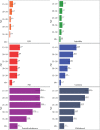Global Contraceptive Failure Rates: Who Is Most at Risk?
- PMID: 30791104
- PMCID: PMC6594038
- DOI: 10.1111/sifp.12085
Global Contraceptive Failure Rates: Who Is Most at Risk?
Abstract
Contraceptive failure is a major contributor to unintended pregnancy worldwide. DHS retrospective calendars, which are the most widely used data source for estimating contraceptive failure in low-income countries, vary in quality across countries and surveys. We identified surveys with the most reliable calendar data and analyzed 105,322 episodes of contraceptive use from 15 DHSs conducted between 1992 and 2014. We estimate contraceptive method-specific 12-month failure rates. We also examined how failure rates vary by age, education, socioeconomic status, contraceptive intention, residence, and marital status using multilevel piecewise exponential hazard models. Our failure rate estimates are significantly lower than results from the United States and slightly higher than previous studies that included more DHS surveys, including some with lower-quality data. We estimate age-specific global contraceptive failure rates and find strong, consistent age patterns with the youngest users experiencing failure rates up to ten times higher than older women for certain methods. Failure also varies by socioeconomic status, with the poorest, and youngest, women at highest risk of experiencing unintended pregnancy due to failure.
© 2019 The Authors. The Population Council, Inc. Published by Wiley Periodicals, Inc.
Figures
References
-
- Ali, Mohamed M. , Cleland John, and Shah Iqbal H.. 2012. “Causes and Consequences of Contraceptive Discontinuation: Evidence from 60 Demographic and Health Surveys.” Geneva, Switzerland: World Health Organization.
-
- Black, Kirsten I. , Gupta Sunanda, Rassi Angela, and Kubba Ali. 2010. “Why do women experience untimed pregnancies? A review of contraceptive failure rates,” Best Practice & Research Clinical Obstetrics & Gynaecology, Abortion and Post‐abortion Care—Volume 1, 24(4): 443–455. 10.1016/j.bpobgyn.2010.02.002. - DOI - PubMed
-
- Bongaarts, John . 2015. “Modeling the fertility impact of the proximate determinants: Time for a tune‐up,” Demographic Research 33(Article 19): 535–560. 10.4054/DemRes.2015.33.19. - DOI
Publication types
MeSH terms
Substances
Grants and funding
LinkOut - more resources
Full Text Sources
Medical



